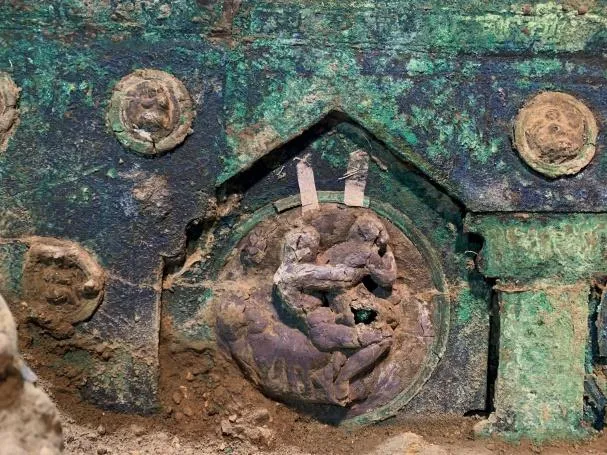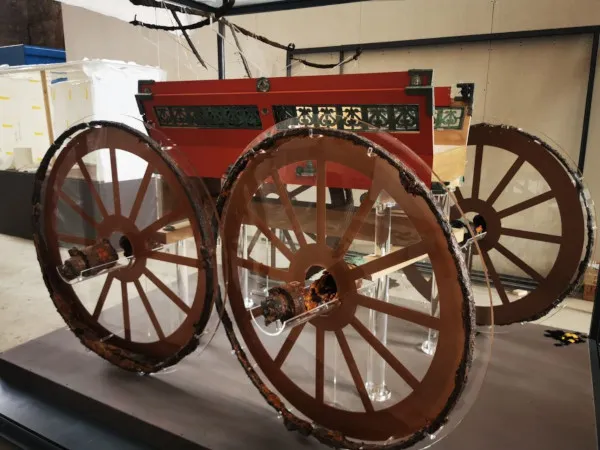Pompeii’s Luxury Find: A Roman Chariot Preserved After 2,000 Years
Researchers in Italy have discovered a well-preserved chariot at a villa outside of Pompeii, the ill-fated Roman city razed by a volcanic eruption in 79 A.D., reports Reuters.

Archaeologists found the vehicle near the stable of a Roman dwelling in Civita Giuliana, a suburb about a half mile northwest of Pompeii. Featuring a seat with metal armrests and backrests, it was supported by four iron wheels and boasted ornate decorations, including bronze and tin medallions depicting satyrs, nymphs and cupids.
Incredibly, notes the Archaeological Park of Pompeii in a statement, the chariot was recovered completely intact, “spared by both the collapse of the [surrounding room’s] walls and ceiling” during Mount Vesuvius’ onslaught and looters’ more recent construction of illegal tunnels. Officials even found imprints of ropes and mineralized wooden pieces nearby.

The chariot is the first of its kind unearthed in its entirety, reports Colleen Barry for the Associated Press (AP). Though experts have previously discovered vehicles used for everyday activities like transportation, the recently found example was too ornate for such purposes. Instead, the team speculates that ancient Romans used it for festivals, parades, weddings and other ceremonial events.
“I was astounded,” Eric Poehler, an archaeologist at the University of Massachusetts Amherst who specializes in the traffic of Pompeii, tells Becky Sullivan of NPR. “Many of the vehicles I’d written about before … are your standard station wagon or vehicle for taking the kids to soccer. This is a Lamborghini. This is an outright fancy, fancy car.”
Excavations at Civita Giuliana began in 2017 in response to the discovery of illicit activity, including looters’ creation of a more than 250-foot network of tunnels.

“The fight against the looting of archaeological sites, both inside and outside the urban area of ancient Pompeii, is certainly one of the primary objectives,” says Chief Prosecutor of Torre Annunziata Nunzio Fragliasso in a press video, as quoted by Valentina Di Donato and Eoin McSweeney of CNN.
In 2018, excavations at the stable across from the double-level portico where the chariot was stored revealed the well-preserved remains of three horses, including one that was still saddled and harnessed. Another major find made at Civita Giuliana came to light last November, when researchers discovered the remains of a wealthy man of 30 or 40 and a younger enslaved man, both eerily frozen in their final death throes.

For now, reports CNN, the carriage is undergoing cleaning at the archaeological park’s laboratory. Restoration and reconstruction will follow.
Mount Vesuvius’ pyroclastic flows and poisonous fumes killed around 2,000 people in Pompeii and the neighboring city of Herculaneum. Inadvertently preserved by the volcano’s ash and pumice, the city’s ruins have fascinated researchers for hundreds of years, with the first systematic excavations of the site taking place in the mid-18th century.
Since 2012, the Great Pompeii Project, an ongoing conservation initiative funded largely by the European Union, has unearthed a stunning array of treasures, from a snack bar that served snails and fish to a sorceress’ kit. To date, experts have exhumed about two thirds of the 165-acre settlement, according to Reuters.

“[The chariot] is precisely the kind of find that one wants to find at Pompeii, the really well-articulated, very well-preserved moments in time,” Osanna tells NPR. “And it happens to be in this case an object that is relatively rare despite its ubiquity in the past.”
Get the latest stories in your inbox every weekday.






